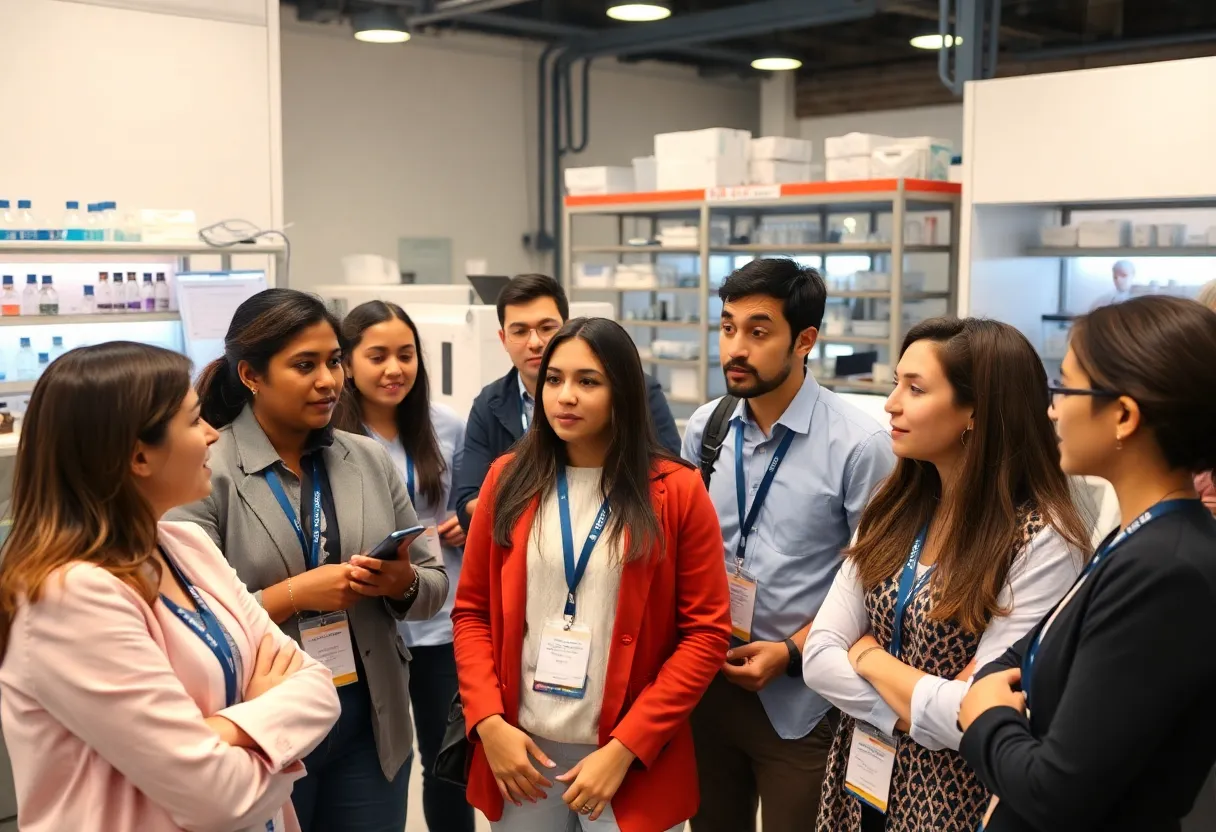Boston, August 19, 2025
News Summary
More than 500 life sciences entrepreneurs gathered at the Nucleate Alumni Summit on Cathleen Stone Island to address the challenges of reduced funding and high lab vacancy rates. Key discussions included a notable decline in venture capital investment and operational hurdles that threaten research and commercialization efforts. Despite these challenges, some entrepreneurs shared success stories of innovation and funding amidst the constrained financial landscape.
Boston — More than 500 young life sciences entrepreneurs gathered at the annual Nucleate Alumni Summit on Cathleen Stone Island to discuss a sector facing sharply reduced funding, rising lab vacancies and mounting operational challenges that threaten research progress and commercialization of new medicines.
Key developments and immediate concerns
The summit highlighted a widespread funding downturn across the life sciences industry. Venture capital investment into Boston-area biotech firms fell to about $3.3 billion in the first half of 2025, marking the slowest pace since the pandemic-era boom. Participants reported shrinking federal support from agencies such as the National Institutes of Health and difficulties obtaining private funding, prompting some founders to lower capital targets.
Commercial real estate metrics underscored the financial squeeze on the sector. Total available lab space in the Boston metro area reached 17 million square feet due to a combination of new construction and high vacancy levels. New lab deliveries pushed the overall availability rate to 29.7% across the region, while Newmark estimated that more than one-third of Greater Boston lab space is currently empty. Over 4 million square feet of lab space remains vacant in the city, and vacancy is rising in suburban markets as well.
Academic and research operations are also strained. Summit participants described academic lab staffing reductions of up to 70% in some cases, and vacancy rates in Greater Boston lab spaces have climbed substantially, reflecting cuts to university research capacity and slowing hiring.
Examples of continued innovation amid funding pressures
Despite the difficult investment climate, some entrepreneurs at the summit reported successful fundraising and grant acquisitions. Examples cited include a new brain implant designed to monitor epilepsy and a cervical cancer therapy that secured a National Science Foundation grant. One founder reduced a fundraising target from $30 million to $15 million in response to the tighter market and still progressed through grant funding and other development milestones.
Industry-wide operational and policy pressures
Attendees raised concerns about rising medicine prices, insurer reluctance to cover costly new treatments, and possible policy moves to limit drug prices. These factors were discussed as potential obstacles to ongoing innovation, regulatory approval and commercial uptake of new therapies. Regulatory hurdles, long development timelines and the difficulty of securing reimbursement were all identified as persistent barriers from initial experiments to market access.
Additional non-financial challenges were also noted, including reduced laboratory space at universities, visa difficulties for international graduates, and broader economic headwinds such as inflation and low consumer sentiment that create market uncertainty.
Global competition and geographic shifts
The summit addressed international dynamics in the life sciences. China was discussed both as a growing supplier of medical products and as a competitive rival in research and manufacturing. Canada’s government-led initiatives to expand its life sciences sector were highlighted as a competitive example. Looking ahead, some executives predicted a reallocation of global biotech and pharmaceutical investments toward locations such as Australia, Saudi Arabia and London, while traditional hubs with deep life sciences ecosystems—Boston, San Diego and San Francisco—may be better positioned to weather near-term challenges.
Technology, workforce and long-term outlook
Speakers discussed technological shifts that could reshape the industry’s operating model. A forecast presented at the summit suggested that advanced artificial intelligence could eventually handle a large share of routine lab work in pharma research and development, with one projection indicating AI could perform up to 90% of lab tasks in the future, fundamentally changing staffing and facility needs.
Participants described a sector at an inflection point: construction continues to add new lab space even as leasing lags, suggesting the softening could persist into 2026 unless leasing activity picks up. Many companies are reducing their real estate footprints and shifting demand from large contiguous lab spaces to much smaller, flexible footprints.
Organizational mission and personal context
Nucleate, the nonprofit host of the summit, supports students and early-career founders pursuing entrepreneurship in the life sciences. Summit leadership emphasized a mission-driven focus on meeting unmet medical needs, reinforced by personal connections to patient care and clinical work shared as background context during sessions.
Near-term catalysts to watch
- Voter decision in Texas: A proposed $3 billion funding initiative for dementia research is pending voter approval and could redirect investment and research activity.
- Policy and reimbursement moves: Potential drug pricing actions and insurer coverage decisions may affect commercialization paths for new therapies.
- Leasing and construction trends: Continued high levels of lab space deliveries without commensurate leasing could prolong market softness into 2026.
Background
The annual Nucleate Alumni Summit convenes early-stage life sciences founders and student entrepreneurs to network, share developments and discuss systemic challenges. The 2025 gathering brought together over 500 attendees on Cathleen Stone Island and combined informal peer workshops with panels on financing, operations and global competition. While the summit included anecdotal success stories, the dominant themes were contraction in available capital, underutilized lab real estate and an uncertain policy landscape that together complicate the path from discovery to patient access.
What this means for stakeholders
Founders may need to plan for smaller funding rounds, prioritize capital efficiency and consider reduced or more flexible lab footprints. Universities and research institutions face difficult choices on staffing and lab capacity. Regional economic development efforts and policy decisions—such as the pending Texas funding measure and national research funding priorities—will influence where research and commercialization activity concentrates in the coming years.
Frequently Asked Questions
What was the Nucleate Alumni Summit 2025?
The Nucleate Alumni Summit is an annual gathering of life sciences students and early-stage founders. The 2025 summit brought together over 500 participants on Cathleen Stone Island to discuss funding, research progress and operational challenges in the life sciences sector.
What are the main challenges facing the life sciences industry?
Participants cited a sharp decline in venture capital, reduced federal research funding, rising lab vacancy rates, staffing cuts in academic labs, visa obstacles for international talent, and concerns over drug pricing and insurer reimbursement as primary challenges.
How severe is the lab real estate oversupply?
Metrics show approximately 17 million square feet of available lab space in the Boston metro area and an overall availability rate of 29.7%. Newmark estimates more than one-third of Greater Boston’s lab space is currently empty, with over 4 million square feet vacant in the city.
Is innovation still happening despite funding pressures?
Yes. Some startups at the summit reported successful fundraising and grant support for new medical devices and therapies, even as many founders adjusted fundraising goals and sought alternative financing paths.
How might global competition change where investments go?
Executives at the summit discussed growing roles for China and Canada, and possible future shifts of investment toward Australia, Saudi Arabia and London. Established U.S. hubs such as Boston, San Diego and San Francisco may retain advantages but could face increased competition.
What policy or funding developments should be watched?
Key items include the pending $3 billion Texas funding initiative for dementia research, federal research budgets, potential drug pricing and reimbursement reforms, and regional economic incentives that affect where companies locate and expand.
Quick Reference: Key Metrics and Facts
| Metric or Item | Figure or Note |
|---|---|
| Summit attendance | Over 500 attendees |
| Boston-area lab space available | Approximately 17 million sq ft |
| Overall metro availability rate | 29.7% |
| Estimated empty lab share (Newmark) | More than one-third of Greater Boston lab space |
| City lab vacancy | Over 4 million sq ft vacant in Boston |
| Venture capital to Boston biotech (H1 2025) | About $3.3 billion |
| Academic lab staffing reductions | Reported up to 70% in some cases |
| Notable pending funding initiative | $3 billion for dementia research in Texas (voter approval pending) |
| Potential geographic investment shifts | Australia, Saudi Arabia, London; continued competition from China and Canada |
| Projected AI impact on lab work | Forecasts suggest up to 90% of routine lab tasks could be handled by AI in the long term |
Deeper Dive: News & Info About This Topic
HERE Resources
Boston Users Critique OpenAI’s GPT-5 Mapping Errors
Boston Embraces AI Innovations and Cultural Celebrations
Boston’s Life Sciences Market Faces Vacancy Spike
Additional Resources
- MassLive: Survivor Life Sciences Edition
- Wikipedia: Life Sciences
- Commercial Search: Tishman Speyer Loan
- Google Search: Life Sciences Funding
- Commercial Observer: Life Sciences Refi
- Google Scholar: Life Sciences Market
- Colliers: Greater Boston Life Sciences Report
- Encyclopedia Britannica: Life Sciences
- The Real Deal: Boston Life Sciences Market
- Google News: Boston Real Estate Trends
- Boston Real Estate Times: Life Sciences Vacancy

Author: STAFF HERE BOSTON WRITER
The BOSTON STAFF WRITER represents the experienced team at HEREBoston.com, your go-to source for actionable local news and information in Boston, Suffolk County, and beyond. Specializing in "news you can use," we cover essential topics like product reviews for personal and business needs, local business directories, politics, real estate trends, neighborhood insights, and state news affecting the area—with deep expertise drawn from years of dedicated reporting and strong community input, including local press releases and business updates. We deliver top reporting on high-value events such as Boston Marathon, Head of the Charles Regatta, and Boston Harborfest. Our coverage extends to key organizations like the Greater Boston Chamber of Commerce and Associated Industries of Massachusetts, plus leading businesses in finance, biotech, and insurance that power the local economy such as Fidelity Investments, Biogen, and Liberty Mutual Insurance. As part of the broader HERE network, we provide comprehensive, credible insights into Massachusetts's dynamic landscape.





